Antibacterial and molluscicidal properties of Agave salmiana Otto ex Salm Dick and Agave beaulerina Jacobi
Yunel Pérez Hernández 1*, Leidy Cortegaza Ávila 2 , Conrado Camacho Campos 1, Yasmary Rubio Fontanills 1, Aymara L. Valdivia Ávila 1, Daynet Sosa del Castillo 3,
Ramón Liriano González 1, Madyu de las Mercedes Matos Trujillo 1, 2,*
Ramón Liriano González 1, Madyu de las Mercedes Matos Trujillo 1, 2,*
1 University of Matanzas, Matanzas city, Cuba.
2 Universidad Central del Este, San Pedro de Macorís, República Dominicana;
3 Escuela Superior Politécnica del Litoral, ESPOL, Guayaquil, Ecuador;
* Correspondence: yunelph77@gmail.com; Tel.: (+53) 51296112
The present work was undertaken to evaluate the phytochemical, antibacterial, and molluscicide properties of Agave salmiana and Agave beaulerina in the Matanzas, Cuba province. Leaves of both species were collected, cleaned, dried, and powdered. The extractions were carried out in 90 % ethanol and distilled water. The qualitative content of various secondary metabolites was determined, and reducing sugars and total soluble proteins were quantified. The antibacterial activity of the ethanolic extracts was assessed against Staphylococcus aureus and Escherichia coli. The molluscicide activity of the aqueous extracts was also evaluated against the snail Praticollela griseola. Terpenes, flavonoids, saponins, tannins, steroids, coumarins, and cardiac glycosides were observed in both plant species. The leaf ethanolic extracts presented an antibacterial effect against both pathogens, although the most significant results were obtained with Agave beaulerina extract. The higher molluscicidal activity was observed with the aqueous extract of A. salmiana, resulting in a 100% mortality after two hours of application. The data would suggest using these plants as a source of bioactive compounds with antibacterial properties. The aqueous extract of A. salmiana could be considered a promising biological molluscicide and an ecological alternative to control Praticollela griseola in vegetable production areas.
Keywords: Agavaceae; biopesticides; mollusks; saponin; Staphylococcus aureus.
INTRODUCTION
The excessive use of antibiotics in medical practice has led to the evolution of many pathogens developing resistance against conventional antibiotics. As such, treating infectious diseases has become a serious challenge and a constant concern of the World Health Organization 1. The plant kingdom is an invaluable resource of chemical compounds with distinct biological activities, so many investigations have focused on searching for new bioactive compounds from plants with antimicrobial activity2.
In intensive agricultural production systems, the systematic application of large amounts of chemical pesticides over the last decades has also concerned the scientific community and the general public. These agrochemicals contaminate the agroecosystems, represent a risk to human health, and enhance the emergence of new pest-resistant genotypes3. Biopesticides derived from plants, on the other hand, have been considered eco-friendly and promising alternatives to those chemicals due to their effectiveness, low costs, rapid biodegradability, and low impact on the environment4,5.
Of the extensive list of crop pests, mollusks are considered one of the most important and challenging to control. In Cuba, the low availability and number of commercial molluscicidal products affect the productivity of several crops, mainly vegetables cultivated under the semi-protected technology6. Furthermore, various species may host helminthic parasites, which can be transmitted to humans and cause several diseases7.
Agave spp. has been traditionally used to obtain natural fibers and produce alcohol for certain beverages such as tequila, mezcal, etc. The genus also contains many metabolites, such as saponins, flavonoids, terpenes, tannins, and coumarins8. Those compounds are the biochemical base for various biological activities previously reported in this group of plants, such as cytotoxicity and anti-inflammatory9, insecticidal10, antibacterial2, and molluscicidal11. However, the phytochemical profile of a plant depends on many factors, including the genotype, plant physiological stage, soil and climate conditions, the method of extraction, etc. For this reason, phytochemical studies need to be done with native plants to make good use of the local flora. The objective of the present work was to evaluate the phytochemical, antibacterial, and molluscicidal properties of Agave salmiana Otto ex Salm-Dick and Agave beaulerina Jacobi present in the province of Matanzas, Cuba.
MATERIAL AND METHODS
Plant material
The experiments were carried out with Agave salmiana Otto ex Salm-Dick var plants. Ferox and Agave beaulerina Jacobi is in the Botanical Garden of Matanzas, province of Matanzas, Cuba. Plant specimens were identified and authenticated by specialists at this institution. Leaves (1.5 kg) without pests or mechanical injury were collected in October 2022 between 8:00 and 9:00 am.
Extract preparations
The fresh leaves were cleaned with distilled water and dried in an oven (Boxun) at 45 ºC. The leaves were pulverized using an electric grinder to obtain a powder with particles smaller than 0.2 mm. Ethanolic (90 %) and aqueous extracts were prepared. One hundred grams of dried and powdered leaves were mixed with 1 L of both solvents and kept on a rotary shaker (HDL® Apparattus) at 160 rpm for 24 hours. The extracts were filtered using a Whatman No. 1 paper filter and concentrated at 45 °C with a rotary vacuum evaporator. The residues were left to dry at room temperature and stored at 4 ºC for phytochemical and microbiological assays.
Phytochemical screening
The qualitative phytochemical study was carried out using standard procedures described by Chigodi et al. 12, to identify the presence of flavonoids, terpenoids, anthocyanins, tannins, saponins, steroids, coumarins, anthraquinones, cardiac glycosides and phlobatannins. The qualitative content was expressed by the non-parametric system: +++ (abundant), ++ (moderate), + (low), and – (absence).
Content of reducing sugars
The dinitrosalysic acid (DNS) method13 determined the reduced sugar content. D-glucose (1 mg mL-1) was used as standard. Absorbance was recorded at 456 nm in a spectrophotometer Ultrospect 2000 (Pharmacia Biotech, Sweden).
Content of total soluble proteins
Total soluble protein concentration was determined as described by Lowry et al.14, using bovine serum albumin (1 mg mL-1) as standard. The absorbance values were recorded at 750 nm in a spectrophotometer Ultrospect 2000.
Calcium oxalate crystal detection
Calcium oxalate crystals were directly observed from the crude extracts using an Optical Microscopy (Olympus) with a magnification of 400X. Photographs were taken to record the presence of crystal structures.
Antibacterial assay
The antibacterial activity of the ethanolic extracts was evaluated against Staphylococcus aureus ATCC 25923 (Gram-positive) and Escherichia coli ATCC 25922 (Gram-negative). The assay was carried out using the agar well diffusion method15. The bacterial strains were previously cultivated on Brain-Heart-Infusion agar medium at 37 ºC for 24 hours. Isolated colonies were taken to prepare bacterial suspensions in saline solutions 0.85 % (v/v). Mueller-Hinton Agar medium was further inoculated with an equivalent cellular concentration of 0.5 in the Mc Farland scale. Wells was done with a sterile borer of 8 mm diameter, and 100 μL of each extract (200 mg mL-1) was added. Plates were incubated overnight at 37 ºC. Cephalexin (50 μg) and amikacin (50 μg) were positive controls for Gram + and Gram – bacteria. The negative control consisted of a hydro-alcoholic solution similar to that used to obtain the extracts. The antibacterial activity was obtained by measuring the diameter of the bacterial growth inhibition zone. Three replications were performed for each assay.
Molluscicidal activity assay
The molluscicidal activity was determined using aqueous extracts of fresh leaves. Before the experiment, the leaves were cut into small pieces, homogenized in distilled water and filtered with a Whatmann No. 1 filter paper, to obtain a concentration of 1 g mL-1, considered the initial solution (100 %). From it, five dilutions were prepared: 1/2 (50%), 1/4 (25%), 1/8 (12.50%), 1/16 (6.25%) and 1/32 (3.12%). The extracts were evaluated against Praticolella griseola (Pfeiffer) snails following the methodology described by Morales-Rabanales et al.16. Five animals were set in Petri dishes (20 cm diameter). The snails were adapted to laboratory conditions for seven days before being tested. Four replications (plates) per treatment (extract) were performed. Four milliliters of each extract and water (control) were applied all over the plates containing the animals and the food (fresh leaves of common bean). Mortality (%) was recorded at scheduled times over 24 hours.
Experimental design and statistics analysis
Molluscicidal assays were conducted using a completely randomized design. The antibacterial activity and the qualitative determination of secondary metabolites were carried out in triplicate, and the absorbance values were used to calculate the content of reducing sugars and total soluble proteins in the extracts.
Data was processed with the statistic pack SPSS version 18.0 for Windows. Data adjustment to a normal distribution was determined through the Kolmogorov-Smirnov test and variance homogeneity by Bartlett's tests. Antibacterial activity, content of reducing sugars, and total soluble proteins data were statistically analyzed by simple analysis of variance (ANOVA). Means were compared using Tukey's multiple ranges comparison test (p<0.05). The mortality percentages were compared using an analysis of proportions with the software CompaProp version 3.01 over Windows 17.
RESULTS AND DISCUSSION
Phytochemical screening
The phytochemical screening results are shown in Table 1. A higher content of reducing sugars was observed in the ethanolic extract of Agave salmiana. The quantification of these compounds in Agave species could be of interest because they may interfere with the extraction of saponins, which have been extensively used for pharmaceutical purposes18. The ethanolic extract of Agave beaulerina showed the highest concentration of total soluble proteins. Ethanol was a better solvent for the extraction of both metabolites than the aqueous counterpart, which results from the difference in polarity between these substances.
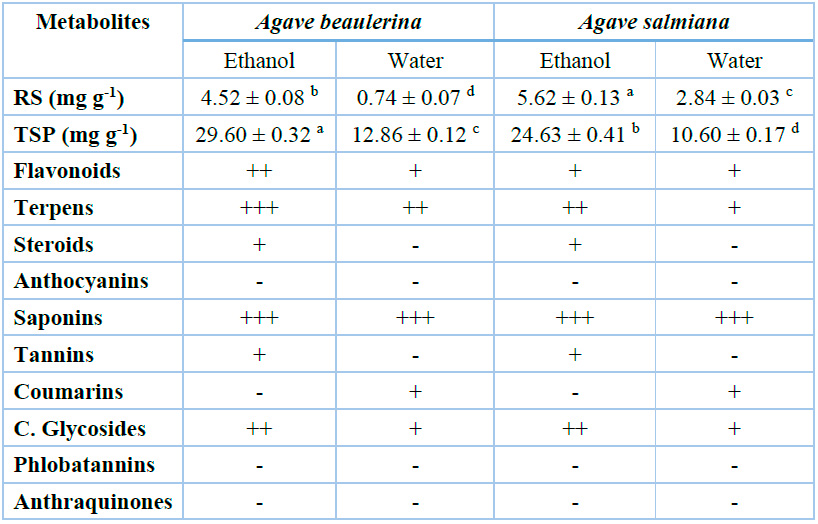
Table 1. Phytochemical composition of ethanolic and aqueous leaf extracts of Agave salmiana var. Ferox and Agave beaulerina Jacobi. RS (reducing sugar), TSP (total soluble protein). Different letters mean statistical difference among extracts (Tukey Test, p<0.05).
Flavonoids, terpenes, saponins, and cardiac glycosides were observed in both aqueous and ethanolic extracts of A. salmiana and A. beaulerina. Steroids and tannins were only detected in ethanolic extracts of both species, while coumarins were found in the aqueous extracts. The obtained results are consistent with the literature reporting the presence of these compounds in Agave species such as A. salmiana19 and A. americana20. However, to our knowledge, there are no reports of phytochemical screening studies on Agave beaulerina Jacobi. The presence of flavonoids, terpenes, and saponins in the extracts of A. salmiana and A. beaulerina, suggests a potential use of these plants as a source of bioactive compounds for developing agriculture and pharmaceutical industry19. Flavonoids and terpenes have been described as antioxidant compounds with anti-inflammatory activity, which may be used to treat different pathologies related to oxidative stress such as inflammatory process, atherosclerosis, Parkinson's disease, Alzheimer's disease, Diabetes mellitus, and cancer21. Saponins have been associated with antibacterial22, molluscicidal4, and cytotoxic activities and are commonly used as a precursor for the synthesis of drugs19.
Antibacterial activity
The ethanolic extracts of A. beaulerina and A. salmiana showed antibacterial activity against Staphylococcus aureus ATCC 25923 and Escherichia coli ATCC 25922 (Table 2). The best results were observed with the extract of A. beaulerina against S. aureus, where the inhibitory effect was similar to that of the control (cephalexin). Similarly, the antibacterial activity of A. beaulerina extract against E. coli was higher in comparison with the extract of A. salmiana.
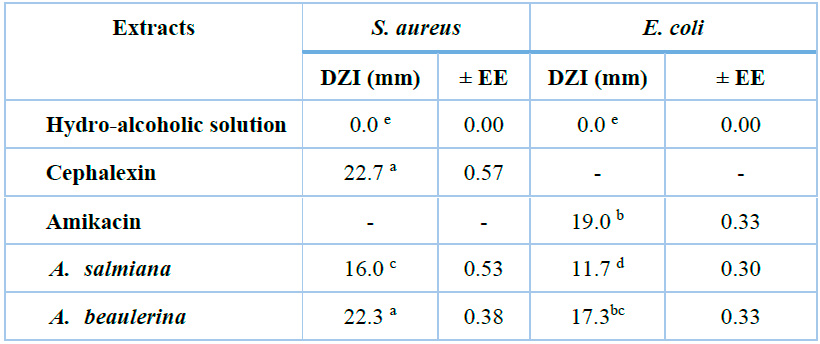
Table 2. Antibacterial activity of Agave salmiana Otto ex Salm-Dick and Agave beaulerina Jacobi's leaf ethanolic extracts against Staphylococcus aureus ATCC 25923 and Escherichia coli ATCC 25922. DZI= diameter of zone of inhibition. Values represent the average of three replications. Different letters indicate statistical differences among extracts and controls for the same pathogen (Tukey test, p<0.05).
The antibacterial activity of Agave extracts has been previously reported in A. americana2 and A. angustifolia23, against various pathogens such as S. aureus, S. epidermidis, and E. coli. Medina-Galván et al.11 reported an inhibitory activity of flower aqueous extract of Agave salmiana against the gram-negative bacteria Listeria monocytogenes, Escherichia coli, Shigella sonnei, and Salmonella typhimurium. However, few studies have been carried out on Agave salmiana to determine its antibacterial properties, and no antibacterial reports have been found in the literature on Agave beaulerina.
The tested extracts of A. beaulerina and A. salmiana showed a higher antibacterial activity against S. aureus, when compared with the inhibitory effect against E. coli. This result may be attributed to the complexity of the gram-negative E. coli cell wall, which reduces the entrance of bioactive compounds with antibacterial activity into the cell24. However, comparable studies with extracts of Agave salmiana showed the maximum inhibitory activity against E. coli compared with the gram-positive S. aureus11. These differences may be associated with the bacterial strains' intrinsic resistance and the plants' phytochemical profile, which depend on their physiological stage, environmental conditions, and the metabolites extraction procedure.
The extracts' antibacterial activity should be related to the presence of secondary metabolites previously identified in the phytochemical screening. Tannins, for instance, may react with proteins rich in proline to form irreversible complexes, inhibiting enzymes' catalytic activity and the biosynthesis of proteins25. Saponins are surfactant substances that alter cell membranes' physical and chemical properties, leading to cellular lysis21. Flavonoids and terpens have also shown antibacterial properties with a noticeable inhibitory effect against several pathogens26.
Molluscicidal activity
Figures 1 and 2 show the results of the molluscicidal activity of Agave salmiana and Agave beaulerina aqueous extracts against Praticolella griseola (Pfeiffer), respectively. A. salmiana evidenced the best results of all the tested concentrations with 100% mortality after 4 hours of extract application, except for the lower concentration (3.1%), in which the activity was statistically similar to that of the control. In the case of Agave beaulerina, the extracts 100%, 50%, and 25% showed similar results (100% mortality) after 24 hours of assay. The application of the extract at 12.5% still reported high effectiveness, identical to those of the extracts mentioned above. However, mortality decreased to 60% with the application of the extract of 6.25%, and the lower concentration (3.12%) showed no difference with the control.
The molluscicidal activities of the assessed Agave extracts are in agreement with other reports and demonstrate the potential of this genus as a source of biocontroling agents for mollusks. The leaf extract of Agave americana was effective against Praticolella griseola Pfeiffer6 and Melanoides tuberculata27. Similarly, Morales-Rabanales et al.16 reported a molluscicidal activity of Agave angustifolia Haw extracts against Fossaria obrussa.
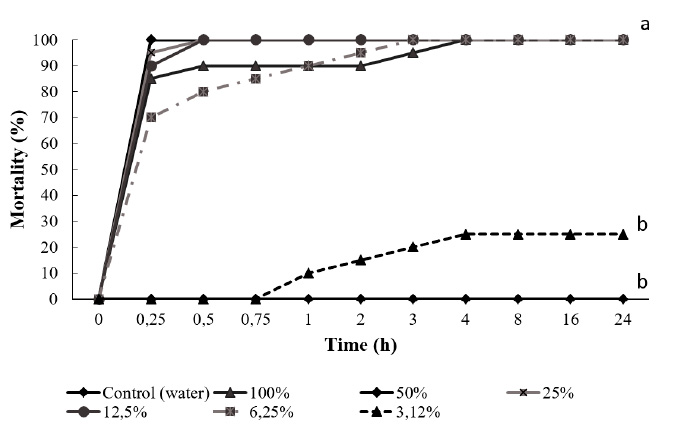
Figure 1. The molluscicidal activity of Agave salmiana Otto leaf aqueous extracts ex Salm-Dick against Praticolella griseola (Pfeiffer). Different letters mean statistical differences among the extract concentrations after 24 hours of application.
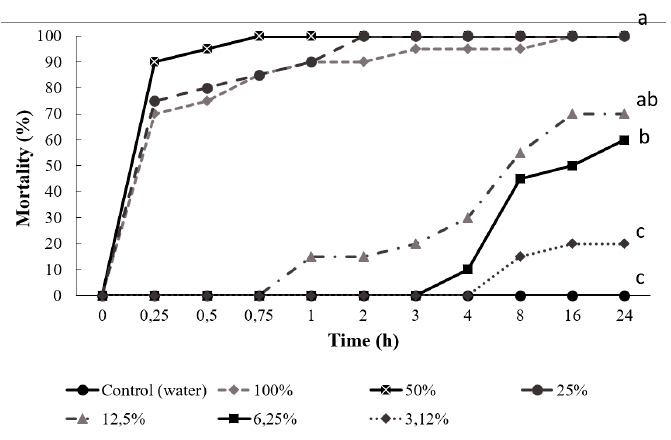
Figure 2. The molluscicidal activity of leaf aqueous extracts of Agave beaulerina Jacobi against Praticolella griseola (Pfeiffer). Different letters mean statistical differences among the extract concentrations after 24 h of application.
The ability of A. salmiana and A. beaulerina to kill mollusks may be related to the presence of metabolites such as saponins, tannins, terpenes, and flavonoids. Saponins, in particular, are well-known to have molluscicidal properties. These compounds may irritate the soft skin and digestive tube of the snails4. Saponins are also toxic over muscles, intestines, hepatopancreas, and hemolymph and may increase the solubility of biological membranes, which results from their amphiphilic nature. This chemical characteristic allows the saponins to interact with sterols present in cell membranes, causing cell rupture and the loss of internal fluids, leading to dehydration of the animal7. In addition, its absorption at high concentrations into the blood circulation may increase cardiac frequency and heart failure28.
The presence of insoluble calcium oxalate crystals in the crude extracts of A. salmiana and A. beaulerina may be involved with the molluscicidal activity of this species29 (Figure 3). Those substances were reported to have a highly irritant effect and could cause the violent reaction observed in the animals when they immediately come into contact with the extracts.
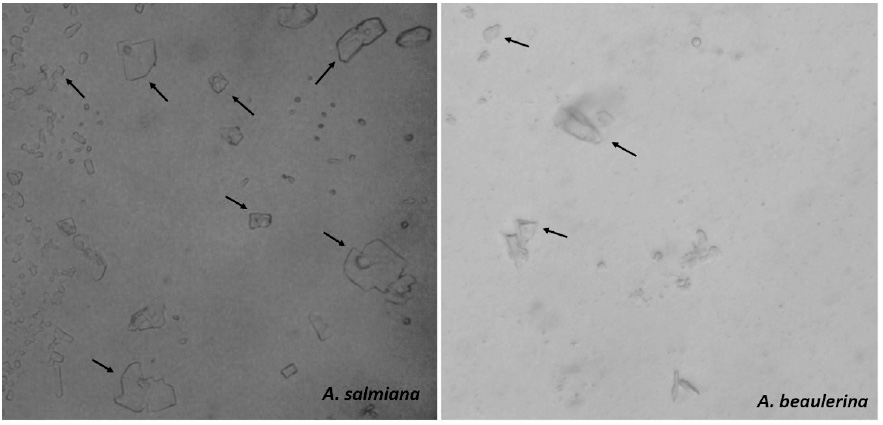
Figure 3. Calcium oxaloacetate crystals in leave juice of Agave salmiana Otto ex Salm-Dick var. Ferox (left) and Agave beaulerina Jacobi (right). Black arrows indicate the presence of crystal structures. Magnifications of 400X.
Some spontaneously retreated inside the shell, while others were vigorously expelled out of the shell by themselves. Oxalate crystals have the potential to inflict mechanical injury to the skin and mucosal linings of the alimentary canal30. The oxalate toxicity involves mechanical abrasion and does not depend on absorption into the body31.
The present investigation has shown that the extracts of Agave salmiana and Agave beaulerina possess antibacterial and molluscicidal properties. The phytochemical, antibacterial, and molluscicidal properties of the extracts of these two species of Agave were evaluated. The phytochemical analysis revealed the presence of various secondary metabolites, including terpenes, flavonoids, saponins, tannins, steroids, coumarins, and cardiac glycosides, in both species. The ethanolic extracts of both plants were found to have an antibacterial effect against Staphylococcus aureus and Escherichia coli, with the Agave beaulerina extract showing the most significant results. Additionally, the aqueous extract of A. salmiana exhibited high molluscicidal activity against the snail Praticollela griseola, resulting in 100% mortality after two hours of application.
The results of this study suggest that Agave salmiana and Agave beaulerina could be promising sources of bioactive compounds with antibacterial and molluscicidal properties. The presence of these compounds in the extracts could be responsible for the observed biological activities. The antibacterial activity of the extracts could be attributed to the presence of saponins, tannins, flavonoids, and terpenes, which are known to have antibacterial properties. The molluscicidal activity of the A. salmiana extract could be due to the presence of saponins, which are known to have molluscicidal properties. The presence of insoluble calcium oxalate crystals in the crude extracts of both species may also contribute to their molluscicidal activity.
Further studies are needed to evaluate the extracts' toxicity and determine the optimal concentrations and application methods for their use in integrated pest management programs. Additional research is required to isolate and identify the specific bioactive compounds responsible for the observed biological activities.
Overall, the findings of this study suggest that Agave salmiana and Agave beaulerina could be potential sources of naturally antibacterial and molluscicidal agents. Using these plants as biopesticides could be an eco-friendly and promising alternative to synthetic pesticides, which are known to negatively impact the environment and human health.
CONCLUSIONS
The leaf extracts of Agave salmiana Otto ex Salm-Dick and Agave beaulerina Jacobi showed the presence of important secondary metabolites such as terpenes, flavonoids, saponins, tannins, steroids, cardiac glycosides and anthraquinones, which are responsible for many biological activities described in these plants. The ethanolic extract of A. beaulerina revealed a high antibacterial activity against Staphylococcus aureus and Escherichia coli. In contrast, the aqueous extract of A. salmiana was highly toxic against the gastropod Praticolella griseola (Pfeiffer) and a promising biological molluscicide. This is the first investigation and use of Agave beaulerina as a potential antibacterial and molluscicidal candidate. Other studies regarding the toxicity of the extracts should be carried out before their use in integrated pest management programs.
Author Contributions: A short paragraph specifying their contributions must be provided for research articles with several authors. The following statements should be used: "Conceptualization, YP; LC and MM; methodology, YP; RL and DS; software, CC and MM; validation, YP; LC and DS; formal analysis, YP, LC, RL and DS; investigation, YP, YR, CC; AV and RL; resources, MM; data curation, YP; YR and MM; writing—original draft preparation, YP and AV; writing review and editing, YP; LC; AV and MM; visualization, RL; supervision, DS; project administration.
Institutional Review Board Statement: "Not applicable."
Acknowledgments: The authors thank Carolyn Amy Elizabeth Brown for the editing work and her suggestions.
Conflicts of Interest: The authors declare no conflict of interest.
REFERENCES
1. Chandra, H.; Bishnoi, P.; Yadav, A.; Patni, B.; Mishra, A.P. & Nautiyal, A.R. Antimicrobial resistance and the alternative resources with special emphasis on plant-based antimicrobials - A review. Plants 2017, 6 (16), 1-11. Doi:10.3390/plants6020016.
2. Shegute, T. & Wasihun, Y. Antibacterial activity and phytochemical components of leaf extracts of Agave americana. Journal of Experimental Pharmacology 2020, 12, 447-454.
3. Devi, P.I.; Manjula, M. & Bhavani, RV Agrochemicals, environment, and human health. Annu. Rev. Environ. Resour 2022, 47, 399 - 421. Doi:10.1146/annurev-environ-120920-111015.
4. Dib, R.; Makhoul, K. & Maalouf, R. Preliminary bioactivity investigation of Styrax officinalis fruit extract as potential biopesticide. Journal of Pharmacognosy and Phytotherapy 2016, 8 (12), 209-213. Doi: 10.5897/JPP2016.0422.
5. Hagag, E.S. Evaluation of metabolites of Myrothecium verrucaria as biological nematicide against root-knot nematode, Meloidogyne incognita in vitro and in vivo on sugar beet plants. J. Plant. Protect. Pathol. 2021, 12, 47-53. Doi:10.21608/jppp.2021.52745.1007.
6. Nodarse, M.; Castellanos, L.; Herrera, N. & Morfa, M. Acción molusquicida de extractos vegetales de tres especies de la familia Agavaceae contra Praticolella griseola (Pfeiffer). Rev. Protección Veg. 2017, 32, (2), 1-7.
7. Abubakar, A.; Bala, A.Y. & Singh, K. Plant molluscicides and their modes of action: a review. International Journal of Scientific Research in Technology, Applied Sciences & Health Studies 2017, 2 (1), 37-49. ISSN: 2579-1036.
8. Bermúdez-Bazán, M.; Castillo-Herrera, G.A.; Urias-Silvas, J.E.; Escobedo-Reyes, A. & Estarrón-Espinosa, M. Hunting bioactive molecules from the Agave genus: An update on extraction and biological potential. Molecules 2021, 26, 6789. Doi.org/10.3390/molecules26226789.
9. Costa, L.T.S.d.; Fracasso, J.A.R.; Guarnier, L.P.; Brito, G.R.d.; Fumis, D.B., Camargo Bittencourt, R.A.d.; Guiotti, A.M.; Barros, D.d.; Camargo, I.C.C.; Souza, E.B.d.; Oliva, P.d. & Santos, L.D. Toxicity and anti-inflammatory effects of Agave sisalana extract derived from agroindustrial residue. Plants 2023, 12, 1523. Doi.org/10.3390/plants12071523.
10. Ontiveros, J.G.; Cerna, E.; Ochoa, Y.M.; Landeros, J.; Aguirre, L.A. & Hernández, A. Insecticidal activity of plant extracts against whitefly nymphs Bemisia tabaci (Hemiptera: Aleyrodidae) in laboratory. Journal of Entomology and Zoology Studies 2020, 8 (1), 595-599.
11. Medina-Galván, M.I.; Bernardino-Nicanor, A.; Castro-Rosas, J.; Negrete-Rodríguez, M.L.X.; Conde-Barajas, E. & González-Cruz, L. Antimicrobial and antioxidant activity of flower scape extracts of Agave salmiana: effect of the extraction solvent and development stage. Research Journal of Biotechnology 2018, 13 (12), 1-9.
12. Chigodi, M.O.; Samoei, D.K. & Muthangya, M. Phytochemical screening of Agave sisalana Perrine leaves (waste). International Journal of Applied Biology and Pharmaceutical Technology 2013, 4 (4), 200-204. ISSN 0976-4550.
13. Miller, G. Use of dinitrosalicylic acid reagent for determination of reducing sugar. Anal. Chem. 1959, 31 (3), 426-428. Doi:10.1021/ac60147a030.
14. Lowry, O.H.; Rosebrough, N.J.; Farr, A.L. & Randall, R. Protein measurement the Folinphenol reagent. J Biol Chem, 1951, 193 (1), 265-275.
15. Perez, C.; Paul, M. & Bazerque P. An antibiotic assay by the agar well diffusion method. Acta Bio. Med. Exp. 1990, 15, 113- 115.
16. Morales-Rabanales, N.; Zumaquero-Ríos, L.; Rojas-García, R.; Vázquez-Cuchillo, O.; López-Pérez, J. & Tovar-Corona, A. Obtaining of polar organic extracts of Agave angustifolia and its evaluation antibacterial and molluscicide. Journal of Chemical, Biological and Physical Sciences 2014, 4 (5), 21-26. E-ISSN:2249 –1929.
17. Castillo, Y. & Miranda, I. COMPAPROP: Sistema para comparación de proporciones múltiples. Revista Protección Vegetal, 2014, 29 (3), 231-234. ISSN:1010-2752.
18. Guerra, J.O.; Nogueiras, C.; Delgado, R. & Hernández, O. Determinación cuantitativa de saponinas y azúcares reductores de Agave briottoniana T. Revista Cubana de Química 2001, 13 (3), 37-42.
19. Santos-Zea, L.; Fajardo-Ramírez, O.R.; Romo-López, I. & Gutiérrez-Uribe, J.A. Fast centrifugal partition chromatography fractionation of concentrated agave (Agave salmiana) sap to obtain saponins with apoptotic effect on colon cancer cells. Plant Foods Hum. Nutr. 2016, 71, 57–63. Doi:10.1007/s11130-015-0525-2.
20. Veni, K. Investigation of phytochemical and antibacterial activity on Agave americana methanolic extract for medical applications. International Journal of Pharma and Bio Sciences 2017, 8 (3): 500 –505. Doi:10.22376/ijpbs.2017.8.3.b500-505.
21. Chaudhary, P.; Janmeda, P.; Docea, A.O.; Yeskaliyeva, B.; Abdull, A.F.; Modu, B.; Calina, D & Sharifi-Rad, J. Oxidative stress, free radicals and antioxidants: potential crosstalk in the pathophysiology of human diseases. Front. Chem. 2023, 11: 1158198. Doi: 10.3389/fchem.2023.1158198
22. Santos, N.J.; Pereira, N.R.; Socorro, M.d.; Pereira, C.A.; Sampaio, T.; Oliveira, E.; Barbosa, J.M.; Lobo, Y.M.; Melo, H.D. & Andrade-Pinheiro, J.A. Evaluation of the antibacterial activity of hecogenin acetate and its inhibitory potential of NorA and MepA efflux pumps from Staphylococcus aureus. Microb Pathog., 2023, 174, 105925. Doi: 10.1016/j.micpath.2022.105925.
23. López-Romero. JC; Ayala-Zavala, J.F.; Peña-Ramos, E.A.; Hernández, J. & González-Ríos, H. Antioxidant and antimicrobial activity of Agave angustifolia extract on overall quality and shelf life of pork patties stored under refrigeration. Journal of Food Science and Technology 2018, 55 (11): 4413–4423. Doi:10.1007/s13197-018-3351-3.
24. Kaczmarek, B. Tannic acid with antiviral and antibacterial activity as a promising component of biomaterials. A minireview. Materials (Basel) 2020, 13 (14), 3224. Doi: 10.3390/ma13143224.
25. Huang, Q.; Liu, X.; Zhao, G.; Hu, T. & Wang, Y. Potential and challenges of tannins as an alternative to in-feed antibiotics for farm animal production. Animal Nutrition 2018, 4 (2): 137–150. Doi:10.1016/j.aninu.2017.09.004.
26. Alcázar, M.; Kind, T. & Gschaedler, A.; Silveria, M.; Arrizon, J.; Fiehn, O.; Vallejo, A.; Higuera, I. & Lugo, E. Effect of steroidal saponins from Agave on the polysaccharide cell wall composition of Saccharomyces cerevisiae and Kluyveromyces marxianus. Food Science and Techonology 2017, 77, 430-439. Doi: 1016/j.lwt.2016.11.048.
27. Iannacone, J.; Cajachagua, C.; Dueñas, B.; Castillo, L.; Alvariño, L. & Argota, G. Toxicity of Agave americana and Furcraea andina (Asparagaceae) on Culex quinquefasciatus (Diptera) and Heleobia cumingii (Mollusca). Neotropical Helminthology, 2013, 7 (2): 311-325. ISSN: 2218-6425.
28. Yong, M. & Rodríguez, M. Evaluación de la acción molusquicida de Agave legrelliana sobre Fossaria cubensis (Mollusca: Lymnaeidae), principal vector de fascioliasis en Cuba. Parasitol al Día, 1994, 18: 46- 50.
29. Perera, C.O.; Hallett, I.C.; Nguyen, T.T. & Charles, J.C. Calcium oxalate crystals: The irritant factor in kiwifruit. Journal of Food Science 1990, 55 (4): 1066-1080. Doi:10.1111/j.1365-2621.1990.tb01599.
30. Salinas, M.L.; Ogura, T. & Soffchi, L. Irritant contact dermatitis caused by needlelike calcium oxalate crystals, raphides, in Agave tequilana among workers in tequila distilleries and agave plantations. Contact Dermatitis 2001, 44 (2): 94–96. Doi:10.1034/j.1600-0536.2001.440208.x.
31. Norton, S.K. Lost seasonality and overconsumption of plants: risking oxalate toxicity. Journal of Evolution and Health 2018, 2 (3): 1-24. Doi:10.15310/2334-3591.1085.
Received: September 23, 2024 / Accepted: November 3, 2024 / Published: December 15, 2024
Citation: Pérez Hernández Y, Cortegaza Ávila L , Camacho Campos C, Rubio Fontanills Y,. Valdivia Ávila A L, Sosa del Castillo D, Liriano González R, Matos Trujillo M M. Antibacterial and molluscicidal properties of Agave salmiana Otto ex Salm Dick and Agave beaulerina Jacobi. Bionatura journal. 2024;1(4):19. doi: 10.70099/BJ/2024.01.04.19
Additional information Correspondence should be addressed to yunelph77@gmail.com
Peer review information. Bionatura thanks anonymous reviewer(s) for their contribution to the peer review of this work using https://reviewerlocator.webofscience.com/
ISSN.3020-7886
All articles published by Bionatura Journal are made freely and permanently accessible online immediately upon publication, without subscription charges or registration barriers.
Publisher's Note: Bionatura Journal stays neutral concerning jurisdictional claims in published maps and institutional affiliations.
Copyright: © 2024 by the authors. They were submitted for possible open-access publication under the terms and conditions of the Creative Commons Attribution (CC BY) license (https://creativecommons.org/licenses/by/4.0/).




